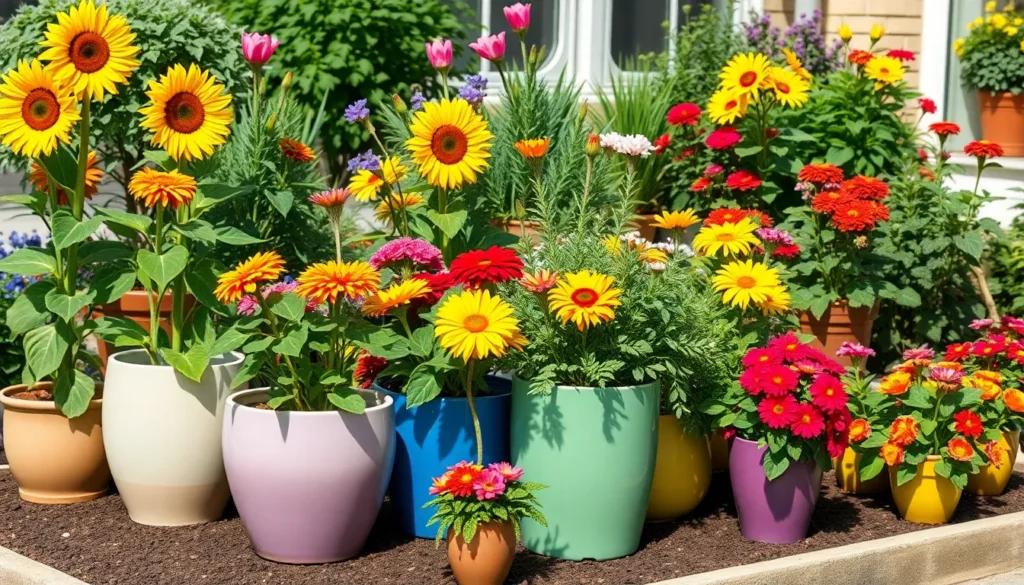We’ve all dreamed of creating that perfect garden display that catches every neighbor’s eye and brings us joy throughout the seasons. Combining traditional flower beds with potted plants offers the ultimate flexibility in garden design – allowing us to create stunning visual impact while maintaining complete control over our plant arrangements.
This innovative approach transforms ordinary garden spaces into ever-changing showcases that we can easily modify based on seasons, plant performance, or simply our changing preferences. Whether we’re working with a small backyard corner or an expansive industry, mixing ground-planted flowers with container plants gives us the best of both worlds.
We’ll explore how this versatile gardening technique can solve common challenges like poor soil conditions, limited space, and the desire for year-round color. From selecting the right containers to creating cohesive color schemes, we’re about to discover why this hybrid approach is revolutionizing how gardeners think about flower bed design.
Choose the Right Location for Your Flower Bed With Potted Plants
Selecting the perfect spot for your flower bed with potted plants determines the success of your entire garden design. Location affects everything from plant health to maintenance requirements.
Consider Sunlight Requirements
Observe your yard’s light patterns throughout the day to identify areas that receive full sun, partial shade, or complete shade. Most flowering plants thrive in locations that get 6-8 hours of direct sunlight daily, while foliage plants like hostas and ferns prefer shadier spots.
Track sunlight exposure during different seasons since trees and structures can create varying shade patterns as the sun’s angle changes. Spring locations that seem sunny might become heavily shaded once deciduous trees leaf out in summer.
Match your plant selections to the available light conditions rather than forcing sun-loving plants into shady areas. Potted arrangements give you flexibility to move containers between locations if needed, but your main flower bed should work with your site’s natural lighting.
Evaluate Drainage Conditions
Test your soil’s drainage capacity by digging a hole 12 inches deep and filling it with water. Well-draining soil allows water to disappear within 6-8 hours, while poor drainage creates standing water that can damage both in-ground and potted plants.
Look for natural water flow patterns in your yard during heavy rainfall to avoid placing your flower bed in low-lying areas where water collects. These spots often stay soggy for days after storms, creating root rot conditions for many plants.
Consider elevation changes when positioning your flower bed since water naturally flows downhill. Slightly elevated areas typically offer better drainage and air circulation around your plants.
Account for Accessibility
Plan pathways that allow easy access to all areas of your flower bed for routine maintenance like watering, deadheading, and seasonal container swapping. We recommend keeping paths at least 18 inches wide for comfortable movement.
Position frequently tended plants within arm’s reach of walkways to minimize stepping on soil or damaging nearby plants. Potted specimens that require daily watering should sit closest to your main garden access points.
Ensure proximity to water sources since container plants dry out faster than in-ground plantings and need more frequent irrigation. Locate your flower bed within 50 feet of a water spigot or plan for hose extensions to reach all areas comfortably.
Select Complementary Containers for Your Potted Plant Display
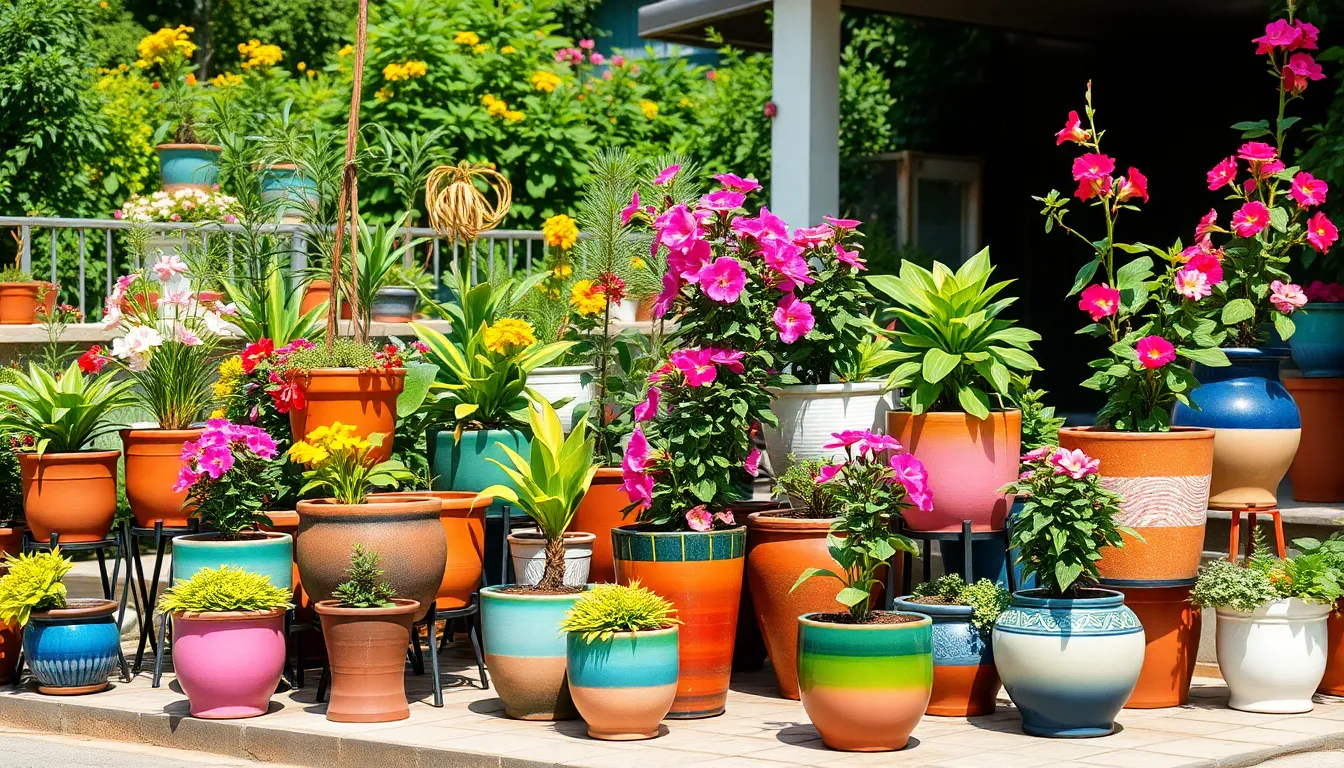
Once you’ve established the perfect location, we need to focus on choosing containers that work harmoniously together to create a cohesive and visually stunning display.
Match Pot Sizes and Styles
Proportional containers create the foundation for successful potted plant displays. We recommend selecting pots that complement each other in both size and style rather than mixing disparate designs that can make your flower bed feel disjointed. When grouping four plants together, arrange them in a square formation with a smaller pot positioned in the center, or use equilateral triangle patterns to maximize aesthetic balance according to research-based design principles.
Scale matters significantly when combining multiple containers. We suggest ensuring your pots are proportional not only to the plants they’ll house but also to each other within the grouping. This creates visual harmony that draws the eye naturally across your flower bed display.
Choose Weather-Resistant Materials
Durable materials ensure your container investment withstands local climate conditions year-round. We prioritize ceramic, glazed pottery, fiberglass, and high-quality plastic for outdoor flower beds because these materials resist cracking during cold weather and prevent fading from intense sun exposure.
Weather resistance directly impacts the longevity of your potted plant display. We’ve found that investing in quality containers from the start saves money and maintenance time over the long term, allowing your flower bed to maintain its appeal through multiple seasons.
Consider Color Coordination
Color coordination unifies your entire flower bed design and creates visual cohesion. We can use neutral-colored containers to let vibrant flowers take center stage, or select colorful pots that echo flower hues for seamless continuity throughout the display.
Elevation adds another dimension to your color strategy. We recommend placing some pots on stands or supports to create layered color combinations and texture contrasts, such as pairing taller plants with shorter ones by positioning them on varied-height stands.
Strategic color placement enhances the overall visual impact. We suggest using the “Thriller, Filler, Spiller” concept when selecting plants: choose a tall dramatic “thriller” plant, add medium-sized “fillers” for volume, and include trailing “spillers” that cascade over pot edges to soften the entire composition.
Plan Your Flower Bed Layout With Strategic Plant Placement

Strategic placement transforms ordinary potted plant arrangements into stunning visual displays. We’ll explore how thoughtful positioning creates depth, balance, and lasting appeal in your flower bed design.
Create Height Variations
Taller potted plants like sunflowers or salvias serve as natural backdrops when positioned toward the back or center of your flower bed. We recommend placing these statement plants based on your primary viewing angle to maximize their visual impact. Shorter plants such as marigolds or zinnias work perfectly along the front edges or borders, creating a cascading effect that draws the eye naturally through the space.
Layering different heights adds dimensional depth that flat plantings simply can’t achieve. We’ve found that incorporating three distinct height levels creates the most ever-changing visual flow. Medium height plants like celosia or gladiolus bridge the gap between your tallest specimens and ground level plantings, ensuring smooth transitions throughout your design.
Design Focal Points
Focal plants or clusters capture attention and anchor your entire flower bed composition. We suggest selecting specimens with bright colors, unique shapes, or striking textures that naturally draw the eye. Position these showstoppers where they’ll be most visible from your main viewpoint, whether that’s a window, patio, or garden pathway.
Grouping pots of similar colors or textures amplifies their visual impact beyond what individual plants can achieve. We recommend clustering three to five containers of complementary plants to create substantial focal areas. Consider mixing different flower forms by combining flat daisy type blossoms with pointed spikes to add textural variety within your focal groupings.
Ensure Proper Spacing
Adequate spacing between potted plants prevents overcrowding and promotes healthy air circulation throughout your flower bed. We calculate spacing based on each plant’s mature size rather than its current dimensions, leaving room for natural growth and development. This forward thinking approach prevents competition for nutrients and maintains the clean, organized appearance of your design.
Proper spacing also ensures easy access for maintenance tasks like watering, deadheading, and seasonal plant rotation. We leave enough clearance between containers to comfortably reach each plant without disturbing neighboring specimens. Consider that potted plants offer unique flexibility for repositioning based on sun exposure changes or when refreshing your garden’s seasonal look.
Pick Plants That Thrive in Both Beds and Containers
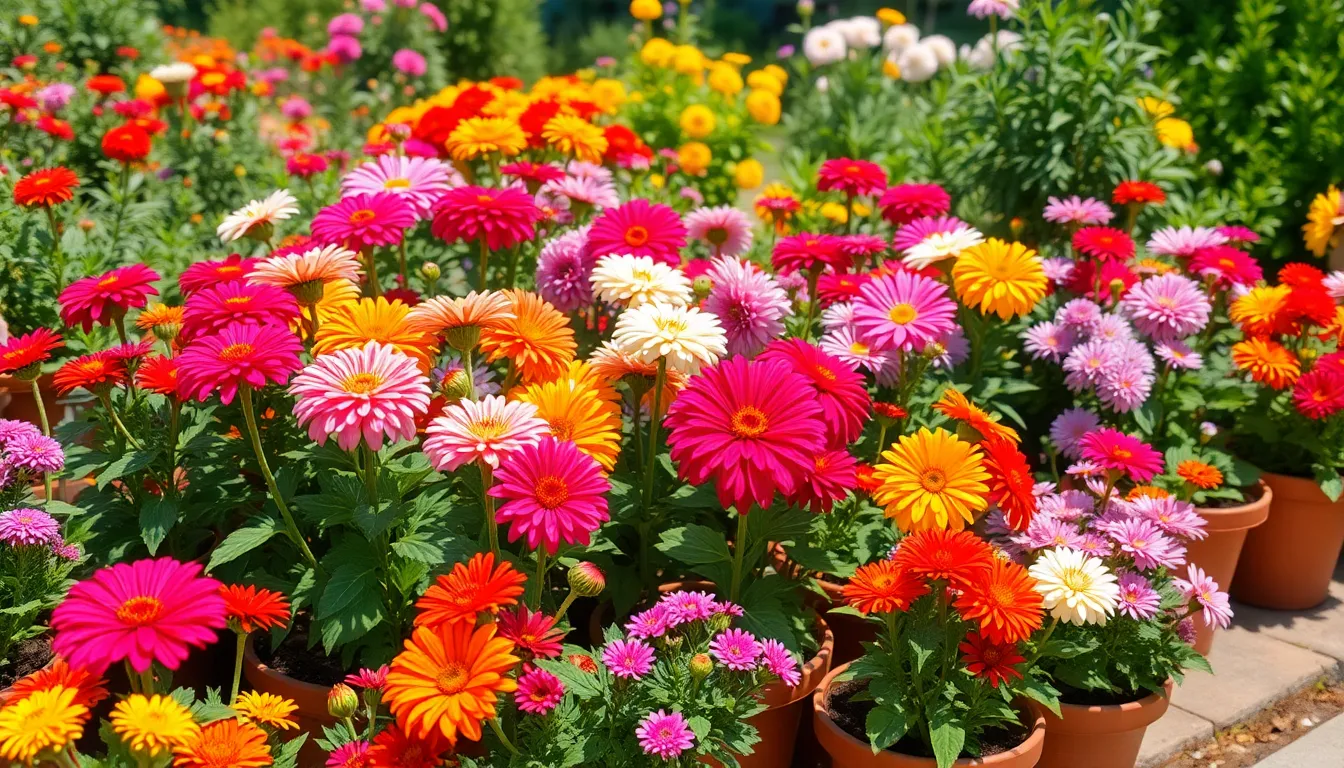
We’ll focus on versatile plants that excel in both garden beds and containers, creating a seamless blend that maximizes our design flexibility.
Select Seasonal Bloomers
Spring planted summer blooming bulbs like caladium, anemones, nerine lilies, and ranunculus work exceptionally well in containers to provide vibrant floral displays during their peak seasons. These seasonal champions allow us to rotate our displays throughout the year, ensuring continuous color and interest in our flower bed design.
Perennials such as begonias, dahlias (especially compact varieties), calla lilies, and elephant ears provide showy summer blooms and interesting foliage that bridge the gap between seasons. Zinnias bloom all summer and can be planted late into the season for extended color, making them suitable for both beds and pots when we need long lasting performance.
Choose Low-Maintenance Varieties
Zinnias stand out as low maintenance options that are drought tolerant and produce abundant blooms with minimal fertilizer or deadheading needed. We can rely on these hardy performers to keep our flower bed looking vibrant with minimal intervention.
Cannas need moist soil and sun but are otherwise easy to maintain, though in colder climates their rhizomes need winter storage. Heat tolerant plants such as lantana also serve as excellent dual purpose choices, thriving in flower beds or containers without demanding constant attention.
Foxtail ferns and calibrachoa represent other easy care options that adapt well to container growth and require little fuss from busy gardeners. Ornamental grasses like fountain grass (Pennisetum) and switchgrass add texture and thrive in containers placed in full sun, creating ever-changing movement with minimal maintenance requirements.
Mix Annuals and Perennials
Perennials provide structure and repeat blooms yearly, with plants like dahlias and begonias in containers serving as reliable anchors for our design. These long term investments create the backbone of our flower bed, returning each season with familiar beauty.
Annuals bring vibrant, often longer lasting blooms and can be changed yearly for variety, with zinnias and lantana offering fresh possibilities each growing season. This combination allows us to experiment with new colors and textures while maintaining established favorites.
Mixing annuals and perennials creates ever-changing, season long interest by layering textures and colors while balancing maintenance needs. We achieve the best of both worlds by combining the reliability of perennials with the exciting seasonal variety that annuals provide.
Prepare Your Soil and Potting Mix for Optimal Growth
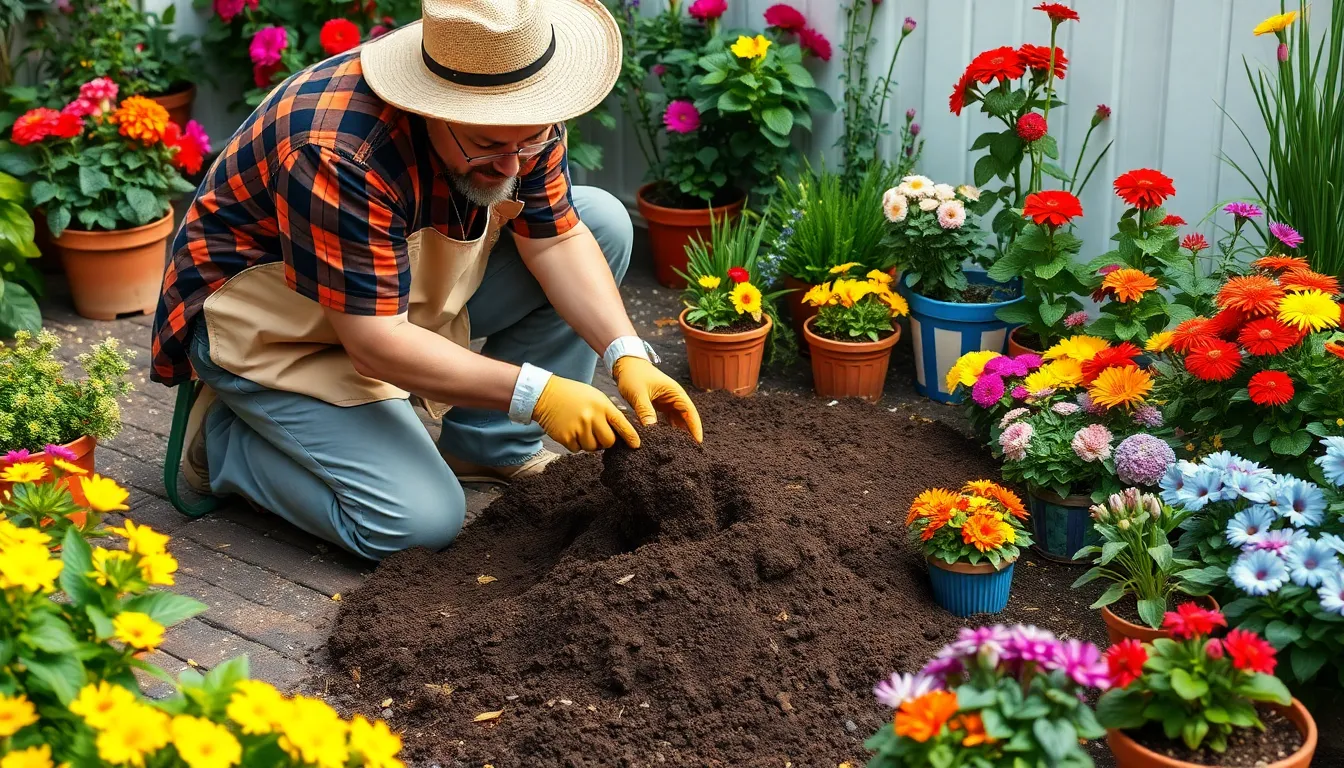
Creating the ideal foundation for your flower bed with potted plants requires careful attention to both garden soil preparation and container growing medium selection.
Test Soil pH Levels
Testing soil pH is essential to identify whether your garden bed has acidic or alkaline conditions. We recommend using a simple soil test kit or digital pH meter to measure the acidity levels in multiple areas of your flower bed. Most flowering plants thrive in slightly acidic to neutral soil with pH levels between 6.0 and 7.0.
Different plants have varying pH preferences, so knowing your soil’s baseline helps us make informed amendments. Acidic soils (below 6.0) may need lime application to raise pH levels, while alkaline soils (above 7.5) benefit from sulfur additions to lower the pH. Regular testing throughout the growing season ensures we maintain optimal conditions for both planted and potted specimens in our flower bed design.
Amend Garden Bed Soil
Working the soil when moist but not wet allows easy turning and mixing without creating harmful compaction. We should turn the soil over to a depth of at least 12 inches to loosen compacted layers and improve root penetration for plants in the flower bed.
Adding 2 to 3 inches of compost or well-finished organic matter into the bed creates the foundation for healthy plant growth. Mix this organic material evenly through the top 6 to 8 inches of soil to improve structure, fertility, moisture retention, and beneficial microbial activity. Organic fertilizers can be incorporated based on nutrient deficiencies detected during soil testing.
Surface treatment completes our soil preparation process by top-dressing the bed with another layer of compost. This additional layer suppresses weeds and preserves soil moisture around both planted specimens and potted plants. Covering with a 3 to 4 inch mulch layer prevents weed seed germination and maintains consistent growing conditions.
Use Quality Potting Soil
Selecting high-quality potting mix formulated specifically for container plants ensures optimal drainage and nutrient availability for our potted specimens. Quality potting soil remains light, well-draining, and rich in organic matter to support healthy root development in confined spaces.
Garden soil should never be used in containers as it compacts easily, drains poorly, and can harbor harmful pests or diseases. Professional potting mixes typically include ingredients like peat moss, coconut coir, perlite, and composted bark to balance moisture retention with proper aeration.
Container plants in our flower bed design depend entirely on the growing medium we provide, making soil quality even more critical than for planted specimens. Premium potting mixes offer consistent performance and eliminate guesswork in creating thriving potted plant displays.
Install Proper Drainage Systems for Long-Term Success
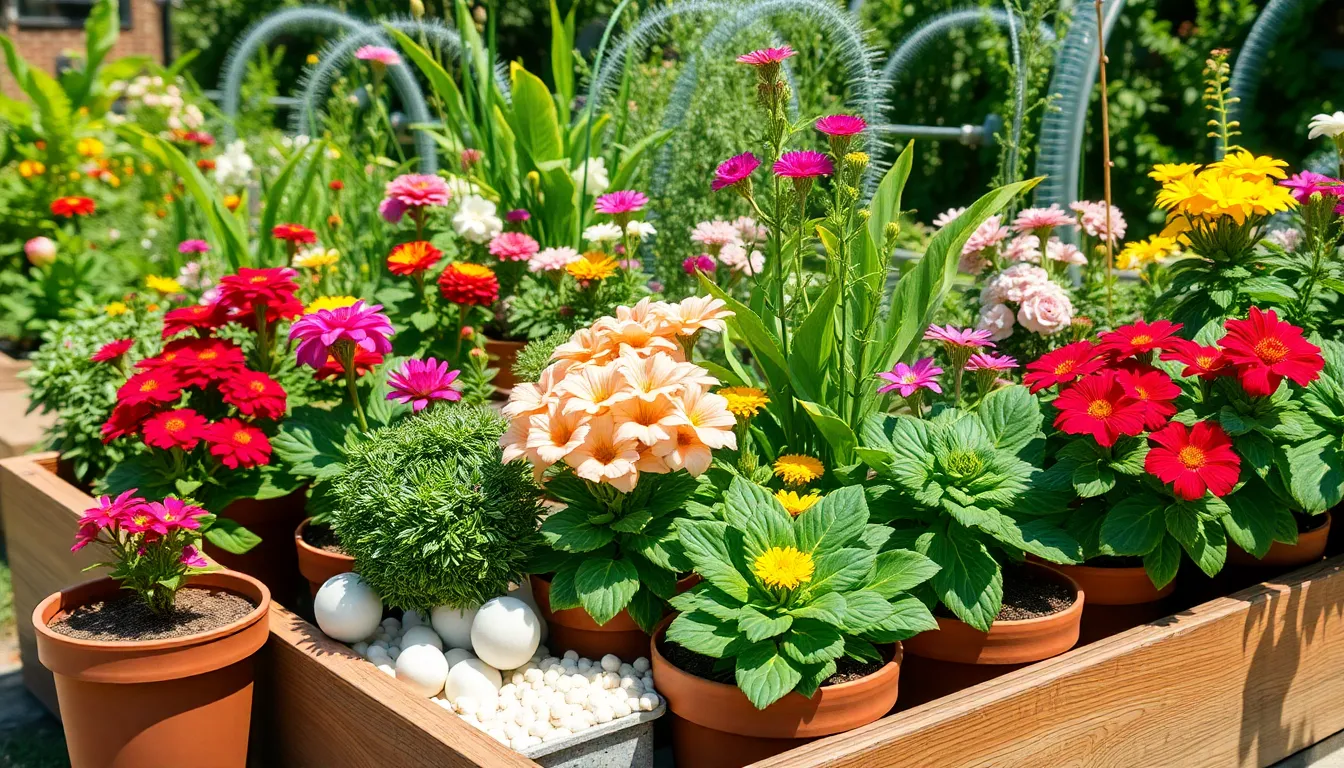
Proper drainage prevents water from pooling at the base of pots, which can cause root rot and fungal diseases. We’ll explore three essential drainage strategies that ensure your potted plants thrive in your flower bed design.
Add Drainage Layers to Pots
Drainage layers inside pots keep soil from blocking holes and promote water flow throughout the container. We recommend placing pea gravel, clay balls, or coffee filters at the bottom of each pot before adding soil. Lightweight recycled materials like “Better Than Rocks” offer improved air circulation without the weight of traditional gravel.
Well-draining potting mix works better than garden soil for container plants since it prevents compaction. Coffee filters serve as an excellent barrier between drainage material and soil, allowing water to pass while keeping particles separated. Clay balls provide excellent drainage while remaining lightweight and reusable for future plantings.
Create Raised Bed Areas
Raised flower bed areas provide better soil aeration and drainage than flat beds, reducing waterlogging risks significantly. We design these elevated areas with adequate grading to channel excess water away from plant roots naturally. This setup proves particularly beneficial in environments with heavy rainfall or poorly draining native soil.
Proper grading ensures water flows away from the planted area rather than pooling around root zones. Raised beds allow us to control soil composition completely, creating optimal growing conditions for both planted and potted specimens. The elevation also improves air circulation around plant bases, preventing moisture-related diseases.
Install Irrigation Answers
Drip irrigation and soaker hoses prevent overwatering by delivering water directly to plant roots in controlled amounts. We use timed irrigation systems to maintain consistent moisture without saturating the soil, complementing our drainage practices effectively. This approach conserves water while avoiding root stress caused by waterlogged conditions.
Targeted watering systems deliver moisture precisely where plants need it most. Automated timers ensure consistent watering schedules even when we’re away, maintaining optimal soil moisture levels. These systems work particularly well with our drainage layers, creating a balanced water management approach for the entire flower bed.
Arrange Your Potted Plants Within the Flower Bed Design
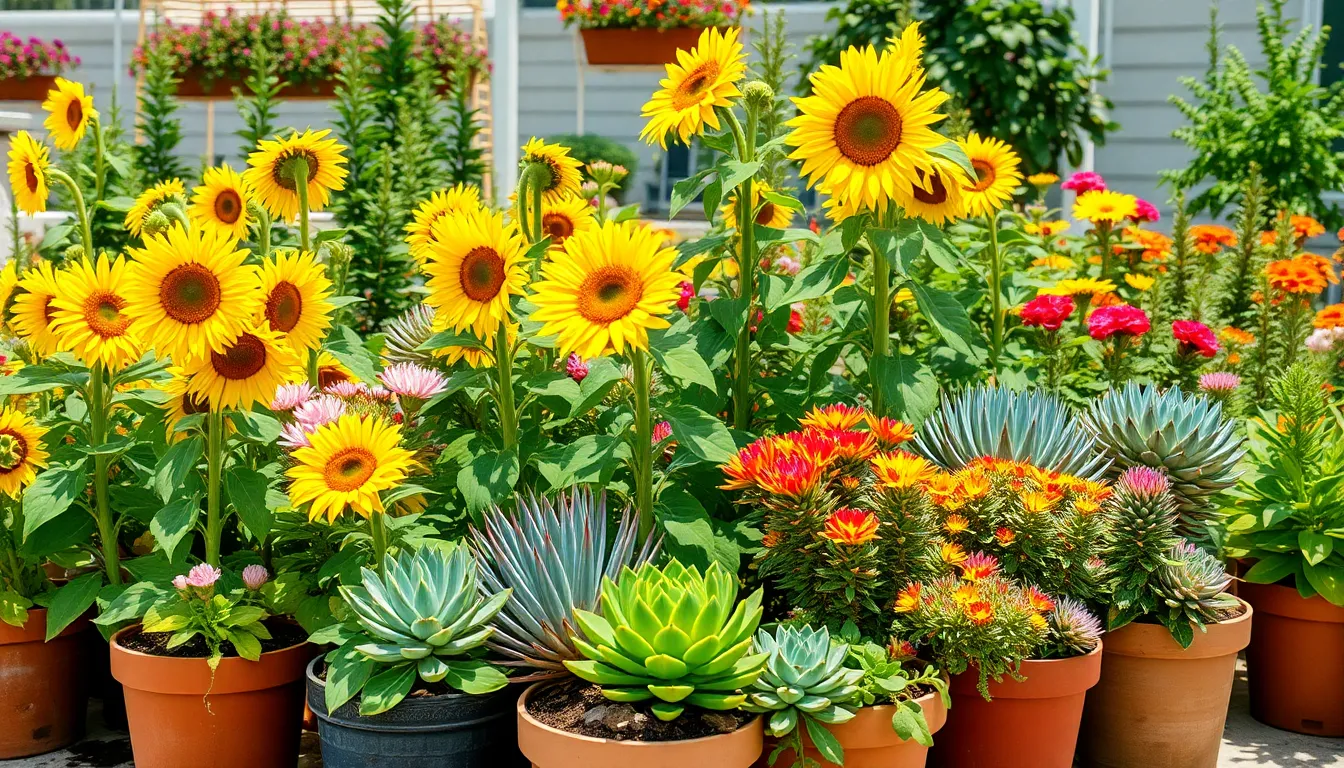
Effective arrangement of potted plants within your flower bed design requires strategic positioning that balances visual appeal with practical care considerations. We’ll create a ever-changing display by implementing three key arrangement principles that enhance both beauty and functionality.
Position Taller Plants as Backdrops
Placing taller plants toward the back of our flower bed creates natural depth and visual hierarchy. We position larger containers with tall specimens like sunflowers, salvias, or ornamental grasses at the rear of our arrangement to form an attractive backdrop. These backdrop plants highlight shorter blooms positioned in front while adding vertical dimension to the overall design.
Structuring our display with height variations prevents a flat, monotonous appearance. We use this layering technique to guide the eye naturally from front to back, creating visual flow throughout the flower bed. The taller plants serve as anchor points that give our arrangement a professional, well-planned appearance rather than a random collection of pots.
Backdrop positioning also maximizes sunlight exposure for all plants in our display. We ensure shorter plants in front aren’t shaded by taller specimens behind them, allowing each plant to receive adequate light for healthy growth. This strategic placement approach creates both stunning visual impact and optimal growing conditions.
Group Plants by Water Needs
Grouping containers based on watering requirements simplifies our maintenance routine significantly. We cluster plants with similar moisture needs together, preventing the common problem of overwatering drought-tolerant plants or underwatering thirsty specimens. This approach ensures each plant receives appropriate care without compromising the health of neighboring plants.
Efficient irrigation becomes possible when we organize plants by their water requirements. We create zones within our flower bed where high-water plants like impatiens and begonias occupy one area, while drought-tolerant succulents and Mediterranean herbs occupy another. This zoning strategy allows us to water each group according to its exact needs.
Water grouping also helps us identify plant stress more quickly during maintenance checks. We can easily spot wilting or overwatering symptoms when plants with similar needs are positioned together, making adjustments before problems become severe. This proactive approach maintains the health and appearance of our entire flower bed display.
Leave Room for Seasonal Changes
Designing our flower bed with flexibility allows for easy seasonal refreshing throughout the year. We intentionally leave open spaces between established plantings where we can introduce seasonal blooms like spring bulbs, summer annuals, or fall mums. This adaptable approach keeps our display vibrant and interesting across all growing seasons.
Strategic spacing accommodates plant growth while maintaining design flexibility. We plan for both the mature size of our permanent plants and the space needed for seasonal additions, ensuring our flower bed doesn’t become overcrowded as plants develop. This forward-thinking approach prevents the need for major rearrangements later.
Seasonal adaptability lets us experiment with new color combinations and plant varieties. We can easily swap out containers or add temporary plantings to complement changing seasons or special occasions without disrupting our established design framework. This flexibility transforms our flower bed into a ever-changing, ever-evolving garden feature that provides year-round interest.
Maintain Your Flower Bed With Potted Plants Year-Round
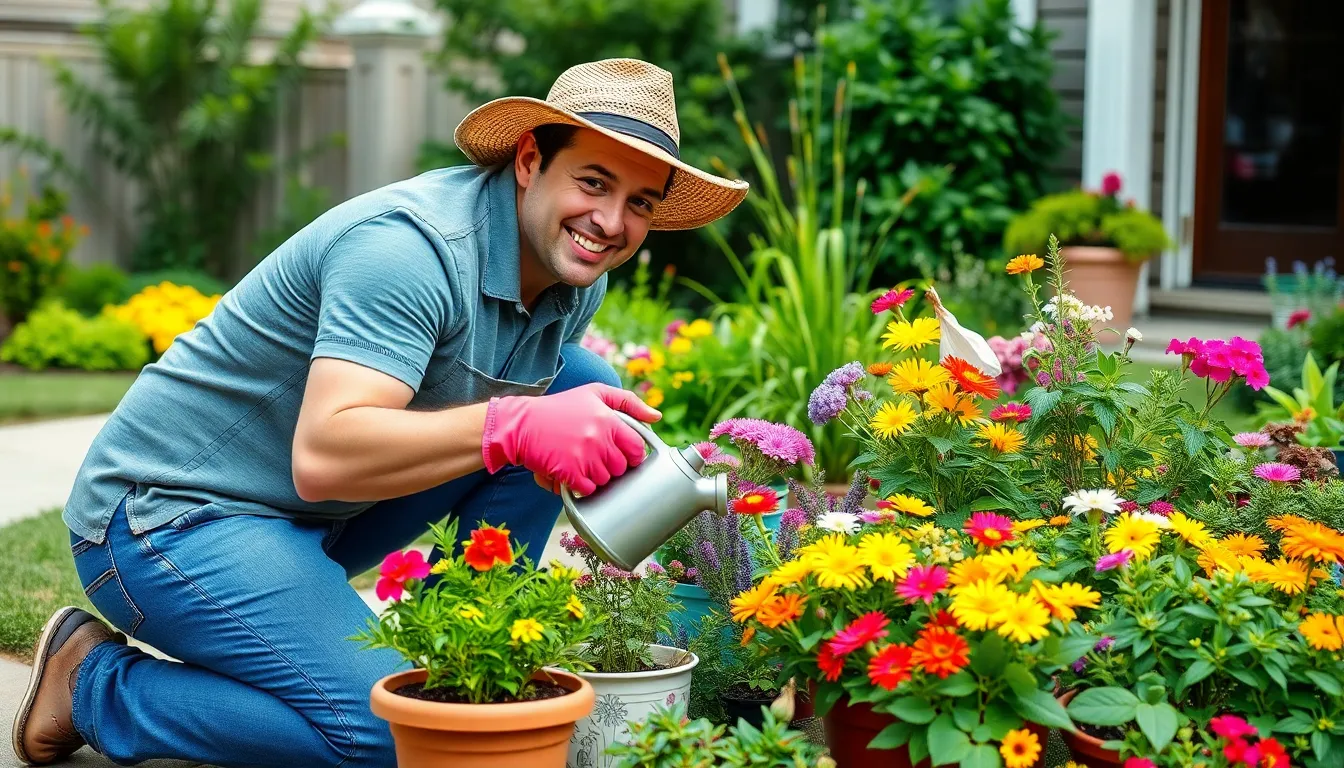
Creating a thriving flower bed with potted plants requires consistent care throughout all seasons. We’ll guide you through the essential maintenance practices that keep your hybrid garden flourishing from spring through winter.
Establish Watering Schedules
Monitor soil moisture levels by inserting your finger into the top inch of soil in both containers and garden beds. Container plants dry out faster than traditional garden beds, so we need to check them more frequently during hot weather and growing seasons.
Water during early morning hours to minimize evaporation and allow plants to absorb moisture before the day’s heat arrives. Direct water at the base of plants rather than on leaves to prevent fungal diseases and ensure efficient water uptake.
Ensure proper drainage in all containers to prevent waterlogged soil conditions that can kill plant roots. We recommend checking that excess water flows freely from drainage holes after each watering session.
Adjust watering frequency based on seasonal changes, weather patterns, and individual plant needs. Summer months typically require daily watering for containers, while spring and fall may need watering every two to three days.
Carry out Fertilizing Routines
Feed container plants weekly or bi-weekly with general purpose fertilizer since nutrients wash away more quickly in pots than in garden soil. Container plants use nutrients rapidly due to frequent watering and confined root systems.
Select fertilizers that include essential trace elements specifically designed for container gardening and soil-less composts. These specialized formulations provide the complete nutrition that potted plants need to thrive.
Apply fertilizer to both container plants and garden bed specimens during active growing seasons from spring through early fall. We recommend following package directions for dilution rates and application frequency.
Suspend feeding during winter months except for short-lived annuals that continue blooming in mild climates. Most perennial plants enter dormancy and don’t require additional nutrients during cold weather periods.
Plan for Winter Protection
Maintain moderate temperatures around your potted plants by moving containers to protected areas when extreme cold threatens. We can relocate pots to covered patios, unheated garages, or against warm building walls.
Shield plants from frost using biodegradable fleece or temporary covers when temperatures drop below freezing. Group containers together to create microclimates that provide mutual protection from harsh weather.
Manage moisture levels by moving plants under cover when soil becomes waterlogged during wet winter periods. Soggy soil combined with cold temperatures can damage or kill plant roots.
Water evergreen plants sparingly during winter months only when necessary, avoiding watering sessions before predicted frost events. Frozen water in plant tissues can cause cellular damage and plant death.
Prepare garden bed areas by adding extra mulch around planted specimens and wrapping sensitive plants in burlap or frost cloth. These protective measures help maintain soil temperature and protect plant crowns from freezing damage.
Conclusion
Creating a flower bed with potted plants transforms ordinary garden spaces into ever-changing displays that adapt to your changing needs. We’ve shown how this hybrid approach offers unmatched flexibility while solving common gardening challenges like poor soil and limited space.
The key lies in thoughtful planning – from selecting the right location and containers to mastering soil preparation and drainage. By combining strategic plant placement with proper maintenance routines you’ll enjoy vibrant displays that thrive throughout the seasons.
This versatile gardening method empowers us to experiment with different arrangements without permanent commitments. Whether you’re working with a small patio or spacious backyard the combination of planted beds and portable containers creates endless possibilities for beautiful personalized garden designs.
Frequently Asked Questions
What is the concept of combining flower beds with potted plants?
This hybrid gardening approach involves integrating traditional in-ground plantings with container plants to create flexible, visually appealing garden designs. It allows gardeners to easily modify displays based on seasons, plant performance, or personal preferences while addressing challenges like poor soil conditions and limited space.
How do I choose the right location for my hybrid flower bed?
Select locations based on sunlight requirements by observing light patterns throughout the day. Ensure proper drainage to avoid soggy conditions, plan for easy accessibility with pathways, and position the bed near water sources. Place frequently tended plants within comfortable reach for maintenance.
What types of containers work best for this gardening approach?
Choose proportional sizes and complementary styles for visual harmony. Use weather-resistant materials like ceramic and fiberglass for durability. Coordinate colors using neutral or colorful pots to enhance the overall aesthetic, and arrange containers in balanced formations for best results.
What plants work well in both garden beds and containers?
Versatile options include seasonal bloomers like caladium, anemones, and zinnias for vibrant displays. Low-maintenance varieties such as zinnias and cannas require minimal care. Combine annuals for seasonal variety with perennials for structure, creating a dynamic and continuously evolving garden design.
How should I prepare soil for hybrid garden designs?
Test soil pH levels to ensure suitable conditions for flowering plants. Amend garden bed soil with compost to improve fertility and moisture retention. Use high-quality potting soil for containers—never use garden soil in pots as it compacts and creates drainage issues.
What drainage strategies are essential for success?
Add drainage layers to pots using pea gravel or clay balls to prevent root rot. Consider raised bed areas for improved soil aeration. Ensure proper grading to channel excess water away from roots, and implement irrigation solutions like drip systems for consistent moisture without overwatering.
How do I arrange potted plants effectively within flower beds?
Position taller plants as backdrops to create depth and visual hierarchy. Group plants with similar water needs to simplify maintenance. Use the “Thriller, Filler, Spiller” concept for layered compositions, and leave adequate room for seasonal changes and proper air circulation between plants.
What maintenance practices keep hybrid gardens thriving year-round?
Maintain consistent watering schedules, especially for containers that dry out faster. Water early morning to minimize evaporation. Fertilize container plants more frequently due to nutrient depletion. Implement winter protection by relocating pots to sheltered areas and using frost covers when needed.

